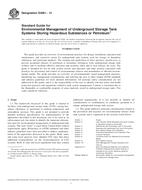Potřebujeme váš souhlas k využití jednotlivých dat, aby se vám mimo jiné mohly ukazovat informace týkající se vašich zájmů. Souhlas udělíte kliknutím na tlačítko „OK“.
ASTM E2681-13
Standard Guide for Environmental Management of Underground Storage Tank Systems Storing Hazardous Substances or Petroleum
Automaticky přeložený název:
Standardní Guide pro řízení životního prostředí podzemní skladovací nádrže systémů skladování nebezpečných látek nebo Petroleum
NORMA vydána dne 1.2.2013
Informace o normě:
Označení normy: ASTM E2681-13
Poznámka: NEPLATNÁ
Datum vydání normy: 1.2.2013
Kód zboží: NS-45864
Počet stran: 17
Přibližná hmotnost: 51 g (0.11 liber)
Země: Americká technická norma
Kategorie: Technické normy ASTM
Kategorie - podobné normy:
Anotace textu normy ASTM E2681-13 :
Keywords:
Energy Policy Act of 2005, operator training, petroleum UST, tank system, underground storage tank, ICS Number Code 23.020.10 (Stationary containers and tanks)
Doplňující informace
| Significance and Use | ||||||||||||||||||||||||||
|
4.1 Environmentally sound management of underground storage tank systems involves a broad range of activities directed toward preventing accidental releases of petroleum or hazardous substances, and effectively detecting and responding to such releases when, and if, they do occur. Numerous technical guidelines are presently available addressing specific procedures for release prevention and response for underground tank systems, including guidelines for tank system design, installation and maintenance, leak detection and spill control, corrective action for affected environmental media, tank system closure, and personnel training. This guide presents an overview, identifying key management considerations and referring the user to other related ASTM standards and industry guidelines for more detailed information. 4.2 Tank System Design and Installation—The first step in environmentally sound management of tank systems is to design and install the tank system so as to minimize the potential for release of petroleum or hazardous substances to the environment. This guide addresses key considerations related to the types of tank systems to be used, compatibility of regulated substances to construction materials, types of spill containment and overfill prevention devices, corrosion protection, proper installation practices, and system inspection and maintenance. 4.3 Preventative Maintenance and Inspection Plan—Even for properly designed and installed tank systems, practical measures are needed to detect and terminate releases in a timely manner so as to minimize regulated substance losses and associated environmental effects. This guide reviews general release detection measures, possible indicators of a release, appropriate record-keeping procedures, leak detection system inspection and maintenance, and response planning and release control measures. 4.4 Fueling Procedure—Careful loading, unloading, and dispensing of liquids to and from underground storage tanks is the most important day-to-day activity to ensure proper handling of liquids and prevention of releases. 4.5 Corrective Action for Affected Environmental Media—Following discovery and control of a release of petroleum or a hazardous substance from an underground tank system, corrective actions may be required for affected soil and groundwater as needed to protect human health, safety, and environmental resources. This guide reviews a risk-based process for investigation, evaluation, and remediation of affected environmental media consistent with the guidelines provided in the Guide E2081. 4.6 Tank System Closure—If it is determined that an underground tank system will no longer be used for regulated substances, the system must be taken out of service, either temporarily or permanently, and, when appropriate, decommissioned and removed in a manner that minimizes the potential for future releases or safety hazards. This guide reviews the general procedures for properly removing tank systems from service, as well as the options for tank system closure by means of tank excavation and backfill placement or in-place closure methods. 4.7 Tank Management Practice Education, and Operator Training—Personnel training is a key element of successful environmental management of UST systems. It is important that persons involved in the installation, operation, or maintenance of tank systems understand the release prevention, appropriate leak detection, and response procedures. This guide outlines the scope and schedule of several key training areas that may be appropriate depending on individual job assignments, including: tank system installation and maintenance; general measures for release prevention; leak detection equipment operation and maintenance; release control and emergency response measures; and regulated substance and waste handling measures. |
||||||||||||||||||||||||||
| 1. Scope | ||||||||||||||||||||||||||
|
1.1 The framework discussed in this guide is limited to facilities with underground storage tanks (USTs) storing hazardous substances or petroleum at ambient temperature and atmospheric pressure. This guide is not intended to provide detailed technical specifications for implementation of the approaches described in this document, nor to be used as an enforcement tool, but rather to identify the important information used for environmental management of underground tank systems. The term “must” is used where United States federal requirements apply. References to ASTM standards and other industry guidelines have been provided to address implementation of the approaches discussed in this guide. Many states and some local agencies have adopted UST rules that place additional responsibilities on the owners/operators of UST systems. Refer to state and local regulations that may contain additional requirements. It is not possible to identify all considerations or combinations of conditions pertinent to a unique underground storage tank system. 1.2 This guide addresses principal considerations related to the prevention and response for environmental releases from tank systems and is organized in the sections listed below:
1.3 The values stated in inch-pound units are to be regarded as standard. No other units of measurement are included in this standard. 1.4 This standard does not purport to address all of the safety concerns, if any, associated with its use. It is the responsibility of the user of this standard to establish appropriate safety and health practices and determine the applicability of regulatory limitations prior to use. Some specific hazards statements are given in Section 7 on Hazards. |
||||||||||||||||||||||||||
| 2. Referenced Documents | ||||||||||||||||||||||||||
|
Doporučujeme:
EviZak - všechny zákony včetně jejich evidence na jednom místě
Poskytování aktuálních informací o legislativních předpisech vyhlášených ve Sbírce zákonů od roku 1945.
Aktualizace 2x v měsíci !
Chcete vědět více informací? Podívejte se na tuto stránku.




 Cookies
Cookies
